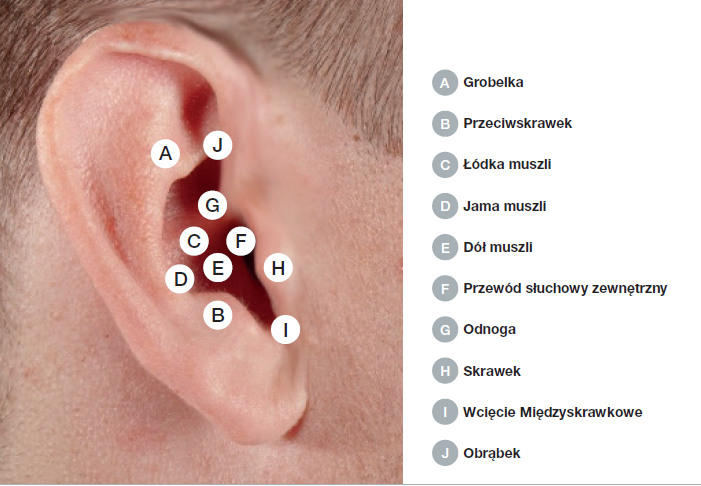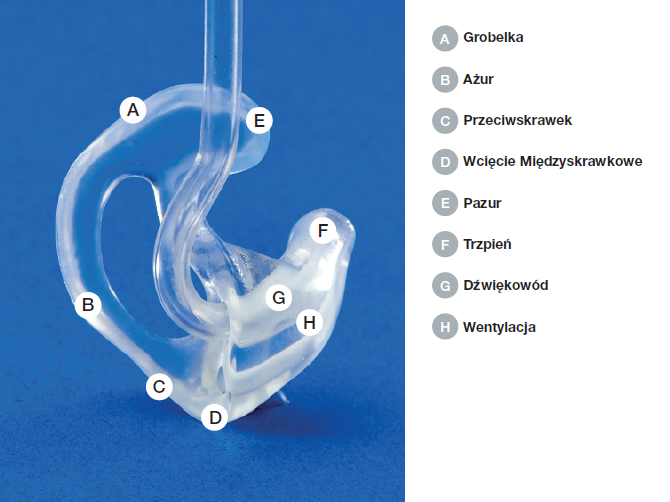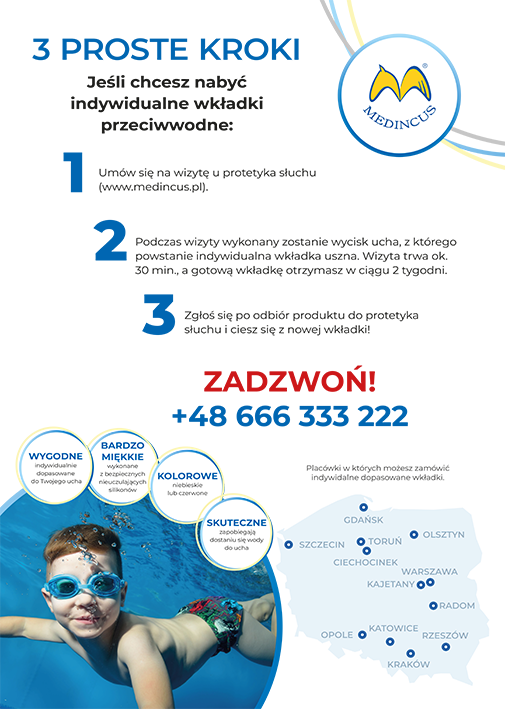The role of earpieces is strongly related to their specific type. Some of them are designed to protect the inner parts of the ear against external factors (water, wind, noise), while others are an integral part of the hearing aid, providing the patient with greater hearing comfort.
Types of Earpieces
The waterproof earpieces protect against bacteria, fungi and contaminants that may be in the water. They are used by both children and adults in cases such as: chronic exudative otitis, ear drainage, paracentesis, eardrum damage, and a tendency to over-produce of earwax. Children may need replacement more often as they grow. It is worth using them especially after ear drainage, because they provide better ear protection than universal earplugs. The shape of the earpieces is individually adjusted to the user’s ears, so you can safely swim or bathe in them without having to fear that water will get into the external ear canal.
The earpieces are an integral part of the hearing aid and are made individually for each patient, adjusting to the dimensions of the ear canal. For this purpose, the hearing care professional takes an impression for each individual’s ears. Taking into account the patient’s hearing loss, the anatomy of the ear, preferences and the model of the hearing aid, you can choose the appropriate shape and parameters of the earpieces, tailored to your individual needs. However, it is always the specialist who ultimately decides which earpiece will be possible for a given patient. A well-made and selected earpiece allows for better sound perception and greater comfort of the hearing aids, while ensuring they function properly.
The task of noise cancelling earpiece is, as the name suggests, protection against excessive noise. They are recommended for everyday use, for example at work (if someone needs silence), but also for sleeping (the soft material does not cause discomfort). The earpieces we offer are free of filters and reduce sounds with an intensity of approx. 30 dB.
To better understand how earpieces work, it is worth taking a closer look at the anatomy of the ear.
The anatomy of the ear:

The auricle is the only visible part of the ear that has a special, slightly spiral shape. It is the first part of the ear that responds to sounds. The auricle acts as a kind of funnel to help guide the sound further into the ear. The lack of auricle makes it more difficult for sound waves to reach the ear canal, and thus further to the ear. Without the auricle, many sounds would be “lost”, making it difficult to hear and understand sounds.
The auricle is essential due to the pressure difference inside and outside the ear. The air resistance is greater inside than outside the ear. The air inside the ear is compressed and therefore more pressurized.
In order for the sound waves to reach the ear in the best way, the resistance must not be too high. The auriclehelps to overcome the pressure difference inside and outside the ear. The correct implementation of a tight and comfortable earpiece largely depends on the correct mapping of the shape of the auricle and the ear canal.
Terminology of the earpiece:

5 steps for a correct fit of the earpiece
- Taking a good Impression
The first step in making the right earpiece and having it be properly mapped is to take an accurate impression. Low-quality impressions will misrepresent the patient’s ear geometry and may lead to frequent visits, complaints, or limit the maximum possible enhancement.

- Type Selection
- An earpiece with a thick tube or ThinTube (TT)
- A micro-insert for the RIE hearing aids
Earmolds with thick tubes and ThinTube can be made of either a hard material (photo-acrylic) or a soft material (Biopor). Earpieces come in many shapes and styles. An alternative to rubber domes are micro-inserts that can be attached to the RIE hearing aids. The use of micro-inserts ensures a more secure fit in the ear, easier insertion and removal of the hearing aid and a lower risk of acoustic feedback in the hearing aids. There are several types of RIE hearing aids and micro-inserts.
- Material Selection
The earpieces are available in two versions: hard and soft. The hard ones are made of acrylic, and the soft ones are made of silicone. Soft inserts can be made in 3 different degrees of hardness. When it comes to colors, there are two standard colors of hard insoles (transparent and pink transparent). It is also possible to order non-standard colors.
- Choice of Ventilation and Duct Length
Ventilation allows air to enter the ear canal and tube. This reduces the likelihood of ear infections. Depending on the patient’s hearing loss, the size of the ear canal and the type of earpiece, you can choose from several sizes of ventilation or no ventilation. Lack of ventilation is an option recommended for people with severe and / or profound hearing loss to maximize amplification and minimize the risk of feedback. You can also decide whether the insert should be long (deep) or short (shallow).
- Additional Options
After selecting the type of earpiece, its parameters, material, ventilation and the length of the duct, there are several additional options that can be adjusted to the patient’s needs, including removing the strap, removing the handle (waterproof plugs only) or having a colored marker. Even personalization is possible, i.e. placing the patient’s initials on the surface of the insert. However, this option is only available with hard inserts.
Information on the use of the earpieces (for hearing aids)
The earpieces are easy to put on and take off as they are custom made. The materials from which they are made are of high quality and are durable.
The earpiece is designed to fit the ear of the individual user and hold the hearing aid in the ear. It also provides a path for the sound generated by the hearing aid and delivered to the ear.
Damaged earmolds must not be used. In case of damage, do not repair the cylinder yourself. Service and repairs should only be performed by qualified technicians.
The hearing care professional shows the patient how to properly insert the earpiece. Each earpiece is custom made to fit the shape of the patient’s ear. The earpieces are usually marked with a dot: red for the right ear, blue for the left ear. If you have any difficulties when removing the earmold, or in any other circumstance, please contact your hearing care professional.
The earpieces should be cleaned daily after each use. Dry earwax particles can stick to the earpiece and become difficult to remove later.
How can I order waterproof earpieces?
Branches where you can order all types of inserts:
- Center of Hearing and Speech Medincus in Kajetany
- Kuyavian-Pomeranian Center of Hearing and Speech Medincus
- Center of Hearing and Speech Medincus in Kraków
- Center of Hearing and Speech Medincus in Warsaw
- Center of Hearing and Speech Medincus in Opole
- Subcarpathian Center of Hearing and Speech Medincus
- Pomeranian Center of Hearing and Speech Medincus
- Center of Hearing and Speech Medincus in Radom
- Silesian Center of Hearing and Speech Medincus
- Center of Hearing and Speech Medincus in Torun
- Warmian-Masurian Center of Hearing and Speech Medincus
- West Pomeranian Center of Hearing and Speech Medincus






